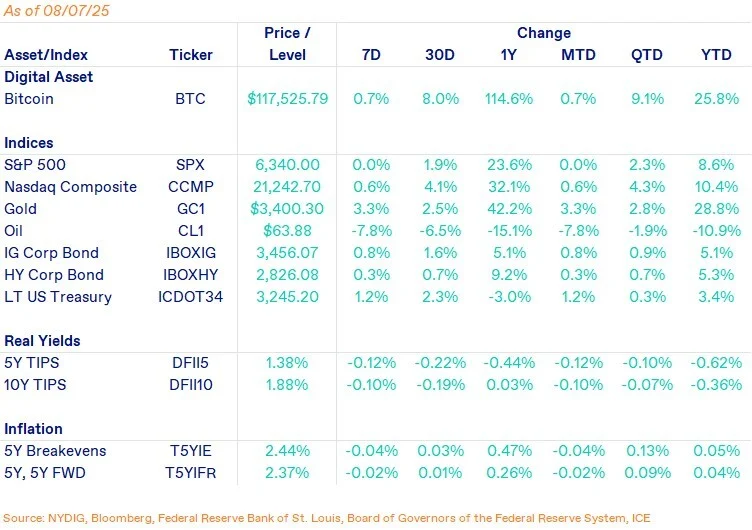IN TODAY'S ISSUE:
- Our new video, “The State of Bitcoin,” breaks down what’s driving bitcoin today and what investors should watch going forward.
- Recommendations from the White House’s report on digital assets put a tailwind behind the industry.
- Unpacking the new SEC Chair’s key crypto initiatives.
- The final pieces of the July 4th Whale puzzle fall into place.
State of Bitcoin Webinar
In NYDIG’s latest Bitcoin Market Update Webinar, the team unpacks a transformative year for digital assets. From the explosive growth of bitcoin treasury companies and record-setting on-chain accumulation to major regulatory shifts under the new U.S. administration, this conversation explores how institutions are engaging with bitcoin in increasingly sophisticated ways. With insights from Greg Cipolaro, Ben Lawsky, and Pete Janney, it’s a must-watch for those navigating the intersection of macro, markets, and digital assets.
To watch the full session, click on the image below:
White House Releases Report on Digital Asset Industry
Last week, the President’s Working Group on Digital Assets released its long-anticipated report, offering a comprehensive overview of the digital asset landscape. The 166-page report is rich with analysis and includes a wide range of recommendations for banking, securities, and commodities regulators, as well as for lawmakers. It presents a compelling vision for the future of the industry and addresses many of the long-standing requests from market participants.
While the White House report itself serves as a non-binding policy roadmap, legislative momentum is already underway, meaning many of these proposals could soon become formalized. If SEC Chairman Atkins’s recent remarks are any indication (see below), both regulators and lawmakers appear increasingly aligned with the report’s direction and are preparing to act accordingly.
The report is dense with insights and recommendations, far too many to cover in full here. However, it covers key areas that the industry has been clamoring for: digital asset market structure, banking, stablecoins and payments, countering illicit finance, and taxation. For readers wishing to get further in the weeds, the table of recommendations beginning on page 145 (through page 163) offers a good summary.
Finally, the report concludes with a section on the White House’s previously issued Executive Order establishing the Bitcoin Strategic Reserve and Digital Asset Stockpile. While we had hoped for an update on the matter, including an accounting of the government’s controlled digital assets, unfortunately, an update has not been provided, at least publicly. There is still some confusion about the total size of the Strategic Bitcoin Reserve and whether roughly half of the alleged balance (198K BTCs) is designated to go back to Bitfinex in connection with its hack in 2016. We are looking forward to an update when one is provided.
Takeaways from New SEC Chair’s Crypto Address
Last week, SEC Chairman Paul Atkins gave his first public address on the agency’s crypto initiatives, dubbed “Project Crypto.” The full remarks, available here, addressed a variety of topics aimed at reshoring the industry and fostering economic growth, a broad alignment with the current administration’s goals. The address is an about-face from the Gensler-era SEC, which tried to wrestle crypto into long-standing securities laws and regulations. Instead, the SEC under Atkins promises to revamp its rulebook and modernize the securities guidelines and regulations to accommodate this new asset class. Here are some of the important areas targeted under “Project Crypto”:
- Capital Formation. Establishing a regulatory framework for distributing crypto assets.
- Crypto Definitions. Most cryptocurrencies aren’t securities, asserted Atkins, but the agency needs to create definitions for securities, digital collectibles, digital commodities, and stablecoins.
- Rules for Crypto Securities. For cryptocurrencies that are securities, the SEC intends to define disclosures, exemptions, and safe harbors, including for Initial Coin Offerings (ICOs) and airdrops.
- Custody. The SEC aims to protect the right to self-custody, something important to many Bitcoiners, but it also aims to modernize the SEC’s crypto custody requirements for registered intermediaries.
- Super Apps. The implication of the wording around this is a bit confusing, as “super apps” already has a commonly agreed-upon definition, but in Atkins’ view, it means regulated entities that trade both securities and tokens side by side. Think Nasdaq or NYSE (exchanges) offering spot bitcoin trading or Goldman Sachs (broker-dealer) acting as an agent (broker) or a principal (agent) in a crypto transaction.
- DeFi Carve Outs. Aktins envisions updated rules and regulations for “on-chain software systems”—what industry participants would more colloquially recognize as DeFi. This would include changes to Reg NMS, a regulation Atkins originally opposed 20 years ago.
- Innovation Exemptions. Finally, Atkins envisions exemptions for innovators to free them from burdensome regulatory requirements to fuel innovation and entrepreneurialism.
We'll be closely monitoring how the new SEC leadership applies this "minimum effective dose" of regulation to the crypto industry. Early signals from the agency, including several notable actions, already suggest a regulatory approach that could serve as a tailwind for the sector. We’re expecting more to come.
July 4th Whale: Coda
Closing the loop on a topic we covered earlier (here and here), the “July 4th Whale.” As a reminder, on July 3rd, 80,000 long-dormant bitcoins, valued at over $9 billion, moved for the first time in 14 years. After a series of transfers, the coins ultimately landed at addresses linked to Galaxy Digital to be sold.
Galaxy later issued a press release confirming its involvement, stating that the movement was related to estate planning. Notably, the transaction was also memorialized on-chain via an OP_RETURN output containing the press release (typo included).
Yesterday, one more piece of the puzzle was filled in, sort of. Salomon Brothers, the “resurrected” investment bank whose trademark was purchased by a group including R. Adam Smith (congrats on the name), according to a 2022 Bloomberg article, issued a press release, filling in some details or at least outlining their thinking.
From our reading, it appears that a Salomon Brothers client sent notices to addresses that they think may be abandoned, an act of community service of sorts. Unfortunately, the press release contains numerous factual inaccuracies and falsities that make this activity appear to be neither well thought out nor chivalrous. Just to dispel nearly every sentence of the press release:
- Lost private keys or abandoned wallets present a network risk – ,no they don’t.
- Rogue nation states and criminal organizations pose a credible threat to hack assets in abandoned wallets – not even close.
- Blockchain experts have identified old encryption protocols as vulnerable – not anytime soon.
- Addresses that received these notices should prove they aren’t abandoned by moving funds or completing a form on the Salomon Brothers website – they must do no such thing.
- A fund is being set up for wallet owners who lost their private keys – if this client can reverse Bitcoin private keys, there are higher value targets than Bitcoin.
A "Wealth of Information," this document is not.
Maybe this is a genuine community effort by Salomon’s client, but it is a misguided one and one without legal standing (or technical knowledge). This seems to be a veiled attempt at allaying the risks associated with Cryptographically Relevant Quantum Computers (CRQCs), something no nation-state, corporation, or educational institution possesses or is even close to possessing. Back-of-the envelope calculations suggest current quantum computers require a 100,000–200,000x improvement before Bitcoin’s digital signature algorithms are endangered. If or when this future state becomes a reality, rest assured, there are better solutions than harassing bitcoin holders with spam messages with zero legal standing.
We called the Salomon blockchain messages to the July 4th Whale as a red herring regarding his or her actions, something we now have confirmation of via the Galaxy news. We also called the Salomon (website) at best a low-effort placeholder, and in the worst case something malicious. It now appears to be the former rather than the latter. This comes from actual blockchain experts and a former member of a #1 Institutional Investor research team at Salomon.
Market Update

Bitcoin closed the week roughly unchanged, capping off a period marked by significant volatility. The turbulence began on Wednesday last week after the FOMC opted to hold interest rates steady, sparking choppy trading. As concerns over the unfolding tariff deals grew, bitcoin began to slide in tandem with broader risk assets. Then, on Friday morning, a weaker-than-expected jobs report intensified market jitters, pushing both stocks and bitcoin lower. At one point on Saturday, bitcoin briefly dipped to $112,000, before staging a recovery to end the week above $117,000.
President Trump was so displeased with the jobs data and previous reporting, which he claimed favored political rival Joe Biden, that he fired Bureau of Labor Statistics Commissioner Erika McEntarfer hours after the announcement. Ironically, had the jobs number been higher, it would’ve made the case of lowering interest rates, something the administration has been clamoring for, an even harder sell with Fed officials.
On the FOMC front, President Trump nominated economic advisor Stephen Miran as a new Fed governor, replacing Adriana Kugler, who was nominated by Joe Biden. While the appointment, if confirmed, advances President Trump’s agenda into what he’s been wanting, lower interest rates, the issue is that one Fed commissioner, even if it’s the Chair, cannot unilaterally set interest rates. Most decisions end with a unanimous vote on a rate decision, but it’s not uncommon to have 1 or 2 dissenting votes. The committee casts 12 votes. In the most recent interest rate decision, the outcome was 9 in favor of holding rates steady, 2 advocating a rate cut, and 1 abstention (Kugler).
Fed officials are contending with varying macro forces, the impact of which is difficult to judge on their dual mandate of maximum employment and stable prices. Specifically, the impact of tax cuts, an increase in deficit spending and changing government spending, deregulation activities, prospects for lower interest rates, and import tariffs, to name a few, has officials juggling between the potential of economic growth and the potential for increased inflation.
Whether the U.S. ends up with higher growth or higher inflation, either outcome seems to favor capital assets (bitcoin, precious metals, stocks, real estate) and punish cash and bonds. Add on top of that eroding trust in governmental institutions and statistics furthered by the firing of the BLS, and we have a nice backdrop for assets like bitcoin.
Important News This Week
Regulation and Politics:
Fact Sheet: President Donald J. Trump Democratizes Access to Alternative Assets for 401(k) Investors - White House
Roman Storm Guilty of Unlicensed Money Transmitting Conspiracy in Partial Verdict - CoinDesk
Trump To Nominate Economic Advisor Stephen Miran to Be New Fed Governor, Replacing Kugler - CNBC
Investing:
Crypto Hoarder Conversion Rush for Listed Companies Worries Backers - Bloomberg
Binance Opens 'BTC Options Writing' to All Users - CoinDesk
Companies:
CoinDesk Owner Bullish Seeks to Raise Up to $629 Million in IPO - Bloomberg
Arkham Uncovers $3.5B Mining Pool Heist, the Largest Ever - X
Ripple to Buy Stablecoin Payments Firm Rail for $200M in Latest Stablecoin Push - CoinDesk
Bakkt to Buy 30% of Japan’s Marusho Hotta, Rename it ‘bitcoin.jp’ in Multinational BTC Treasury Push - The Block
Figure Announces Submission of Draft Registration Statement - Figure
Stone Ridge Buys Oklahoma Assets From ConocoPhillips - Stone Ridge
Upcoming Events
Aug 12 - CPI report
Aug 21 - Jackson Hole Economic Policy Symposium
Aug 29 - CME expiry
Sept 17 - FOMC interest rate decision





